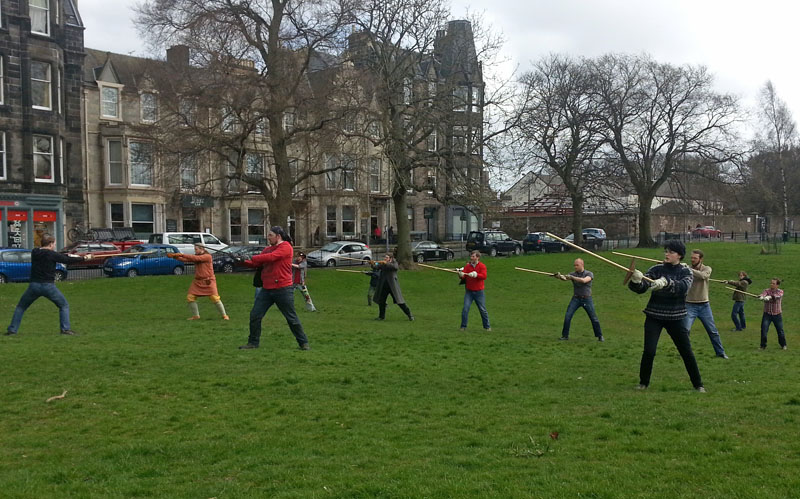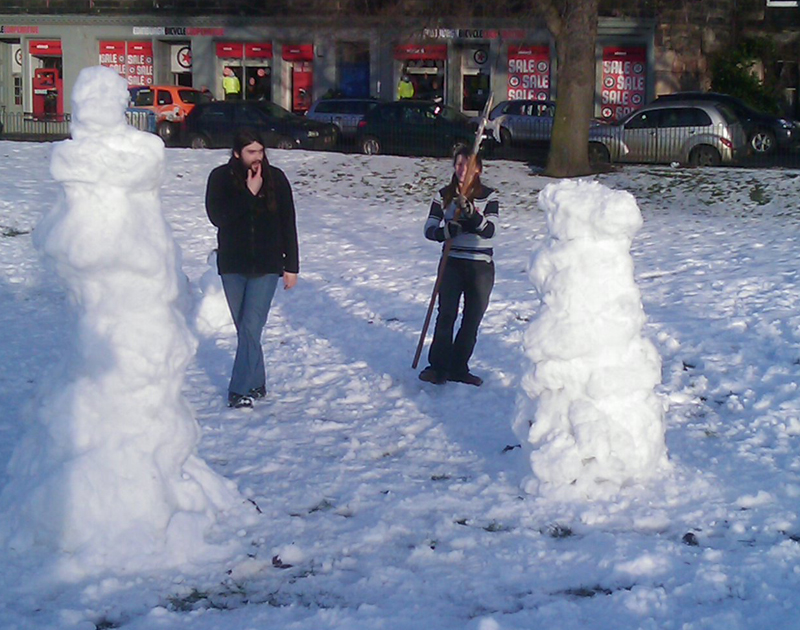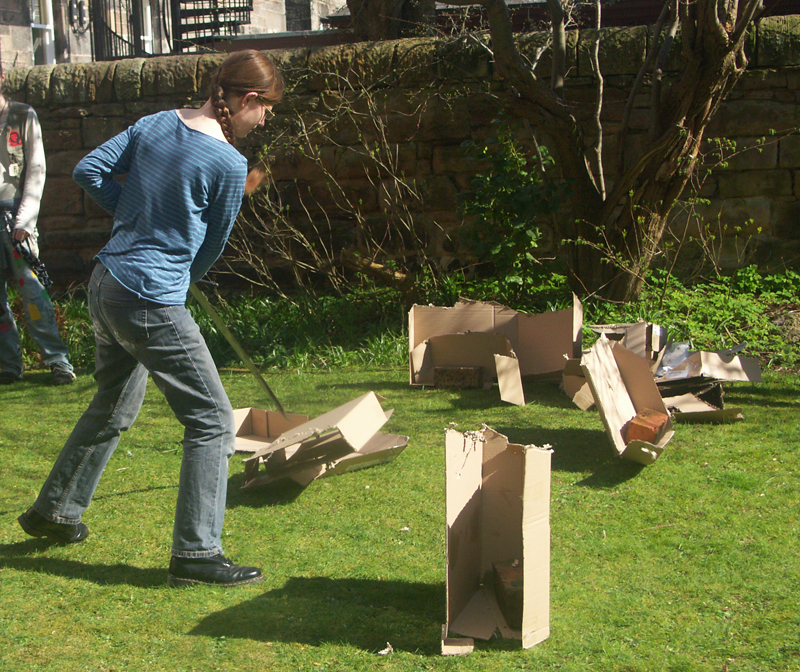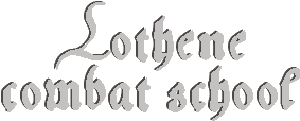Combat practice is held on Bruntsfield Links each Sunday afternoon between 2pm and 4pm.
Our objective is to study the martial arts of late mediaeval and renaissance Europe, practicing in the way they did at the time.
You will begin by training with the longsword, as our ancestors did. Initially you will learn how to stand and move, then how to co-ordinate your attacks and movement. Then you will be taken through a series of “Flourishes” (practice drills which teach the principles of defence and attack). Once you have a solid grounding in these you will begin sparring in practice combat.
Once you are reasonably adept with the longsword you can move on to other weapons such as the single sword, staff, pole weapons, daggers etc.
 Longsword drill Longsword drill
The practice weapons made of wood & leather are the property of the group and can be used by anyone. The subscription we ask of our members (currently £5 per term) is used to supply these weapons and the communal gloves. The steel weapons (and some of the wooden ones) are the property of individuals – please don't touch steel weapons without the owner's permission. We are all usually quite keen to show off our weapons if you ask!
When you first join you will be at the rank of Scholar. At this level you are learning the basics, and so should not engage in sparring with another Scholar unless supervised by a Provost. Once you have achieved a level of experience and control which I believe makes you safe to spar without the supervision of a more experienced member, you will be raised to the rank of Free Scholar. The most skilled members who have also proven their ability to teach and assist in running the school others have the rank of Provost.

We practice in most weather conditions throughout the year. The group built these snow men and used them for target practice.
SAFETY AND COMBAT ETIQUETTE
We want Lothene to continue to be a safe, injury free group. It is a contact sport, and we do get occasional bruises but rarely anything more than that. You must always take care of your own safety and the safety of others. There is nothing at stake but your ego, and you must always be prepared to lose rather than risk hurting someone.
This is a physical activity in the outdoors so wear sensible clothes for the weather conditions, including long sleeves and gloves. If you have suitable period clothes, and particularly shoes, then wearing them will be helpful as they affect how you stand and move. Since the footwork requires you to be able to swivel on the balls of your feet, smooth soles to your shoes are very helpful. Too much grip is a hindrance as it prevents you stepping correctly. If you are wearing modern clothes make sure you have a full range of movement, particularly for your arms. To avoid damaging them, or an injury being caused by them, please remove rings, watches, bracelets, mobile phones and other large or dangling jewellery. If you have long hair tie it back so it doesn’t get in your eyes.
Valid areas to land blows on your opponent, provided they are pulled so as to only touch hard enough for them to feel it, are the front and sides of the body from below the collar bones to above the knees (avoiding “delicate” areas like the groin) and arms above the wrist. This is because the other areas are likely to cause real injuries if you hit them. Of course, in a real fight there are no “off limits” targets so attacks can and should be made to anywhere, just make sure you pull the blow short if it is outwith the permitted areas. Since we are training rather than fighting “to the death” this reflects what our ancestors would mostly have done (though they were a bit more prepared to take injuries in practice than we are, and some teachers advocated the use of sharp weapons as anything else wasn’t real enough!) If you fail to defend yourself against an attack we expect you to acknowledge it as a “hit” whether or not it actually touches you. If the reason you weren't touched is because your opponent was being careful of your safety, be grateful and reward them by allowing them the “point”. The head was the primary target, so make sure you defend yours.
If you push yourself too hard you will lose fine control, and this both increases the risk of injury and reduces your ability to learn correct technique. Stay within your limits. Only take part in combat when you are safe to do so. Reasons why you might not be safe to do so include being:
- overtired
- too cold
- too hot
- not confident in your opponent
- under the influence of alcohol or other drugs/medication.
You can always decline an offer of combat without giving a reason. Don't press others if they decline an offer of combat from you. If you're not sure you're safe then don't fight. If you can't safely fight, you may be able to do drills. If you start to tire, take a break. While it is fine to spend some (or all) of a practice just watching, please don’t distract anyone who is trying to practice. We usually go for a drink afterwards, and that is the opportunity for random chatter. While we are on the field our priority is to train.

The purpose of this exercise was to practice cutting strokes at full force. When fighting a real opponent
blows are pulled short, but it can help to know how the real thing works.
The thick cardboard boxes provided quite a bit of resistance when cut and if you don't get the angle right
it tends to bounce off.

Remember, we may be just playing when we fight but in the past people were learning these skills to keep themselves alive. Our techniques are all derived from the surviving records, and we are practicing them as a practical martial art to train for deadly combat. If you are used to another style you will need to “unlearn” it.
We recommend in particular that while beginning to practice with us you avoid the modern re-enactment style, which compared to real combat is greatly simplified and uses a restricted set of target areas. This, combined with people treating it as a competitive sport, has resulted in the evolution of unrealistic techniques which allow the user to accumulate a score of “kills” by taking advantage of the limitations imposed by the rules. Such behaviour is contrary to learning to fight effectively. Having landed a technical hit which does no real damage is small comfort if your skull is crushed in response. Anyone can claim an artificially inflated “score” by taking advantage of the necessary compromises made for safety to use techniques that would not work in a real encounter, but within Lothene you will not be respected if you do this and will find people reluctant to practice with you.
If you hear "Hold" being shouted then cease to move and attack but do not cease to defend yourself until you are sure your opponent(s) have also stopped. You can call a Hold at any time if you become aware of a danger. Examples of reasons for this are stray children wandering into the combat area, your points giving was so your breeches are falling down, or having pulled a muscle.
Please ensure that you have up to date tetanus jabs, etc. We have several qualified First Aiders and bring a first aid kit to practices, but hopefully that won’t be necessary. However, please do notify us of any relevant health issues – we’ll keep them in confidence unless you tell us otherwise. The things we need to know about are communicable diseases, (do we need to take extra care if you are bleeding for example?) old injuries/disabilities (dodgy ankles/knees, bad backs, and shoulders prone to dislocation are all things we’ve had to deal with) and conditions such as asthma, allergies and cardio-vascular issues. This is so we can avoid setting things off and be prepared if they do happen. We will fit the training you do around any particular needs you have. In the past for example we have avoided closing and grapples with a student who had personal space issues and panicked if anyone got too close.
Members Page |

